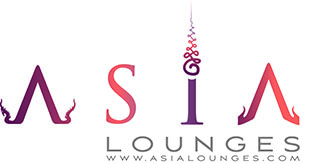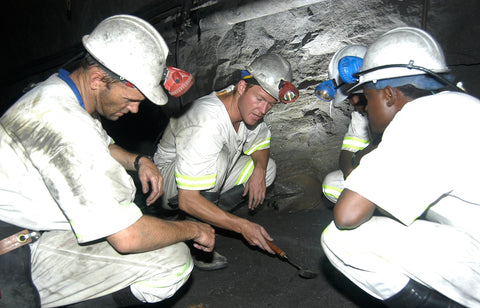Hey Loungers,
Today we interview yet another one of our South African pals that’s been involved in gem mining for over 14 years.
Robert’s career started working underground for TanzaniteOne for 6 years from 2003 to 2008 as a Junior Geologist working his way up to Mine and Exploration Geologist for the company. He is the reason why so many of you have been able to see these gorgeous gems known as Tanzanite, and followed that up with 6.5 years working for Gemfields as Senior Mine Geologist on their Kagem Emerald Mine in Zambia; and is now working on his very own brand: Gessner Gems (IG: @thekingofgemstones)
But enough with the chit chat, Robert, the floor is yours!

Robert Gessner as you see him today in most Gem Shows around the world or with us today in the Lounges - Photo Credit: Gessner Gems
AsiaLounges: First of all, thank you, Robert, for being with us today to answer to our questions. Let’s enter the fray our traditional way, tell us more about you. Who are you: Robert Gessner?
Robert Gessner: Firstly, thank you for this wonderful opportunity, AsiaLounges. I am a coloured gemstone geologist and gemmologist, and I am coming up on 17 years’ experience in the trade. What sets me apart from all my peers is that my background is not only in Africa, but also with the world’s largest professionally-mined coloured gemstone mines, namely TanzaniteOne, and Gemfields. I was there almost from the beginning of both success stories.
I love learning, growing and evolving, both personally and professionally. And we have one of the best careers as professional growth ties in with personal growth within this industry of ours. I love traveling, cultures and languages, and meeting the people of where ever I travel to. I have always considered the world as my oyster. As my career evolves and develops, a significant personal goal is to be giving back to our industry, our community and the public, in any way I can.
AsiaLounges: I have already asked that question to our other South African friends that came through our pages but, it always amuses me. What makes you lads in South Africa so prone to go into the gem mining industry? And most interesting, what drove you to mining and to TanzaniteOne?
Robert Gessner: I spent most of my childhood in Cape Town where there is no mining industry, however was always very aware of the geological riches South Africa has. Probably due to the British-based education system subject of geography, a good general knowledge, and traveling through the country with my family on school holidays. And I am only referring to the commercial mining industry here. When one is talking about the diamond mining industry, then ‘diamond’ is specifically mentioned, because the mining communities are so different. There is, of course, a massive mineral specimen collecting community too, but, honestly, and at that stage of my life, was not aware of a large coloured gemstone community and industry in South Africa.
I studied Geology at the University of Cape Town, and like all students, if you did not have a bursary or scholarship from a mining organisation, you would contact recruitment agencies or directly apply to jobs to seek out employment opportunities. I was no different. With nothing on my resume at the age of 22, submitted my resume to a recruitment agency. To this very day, whether it was timing, divine intervention, or plain luck, within a couple of months of my submission, they got back to me saying a mining company in Tanzania was looking for a geologist. This company turned out to be a small private mining in the initial stages of developing the Block C Tanzanite Mine, which later would become TanzaniteOne.
Here is Robert inspecting a natural piece of Tanzanite in the depth of Tanzanite Block C - Photo Credit: Brendan Laurs
AsiaLounges: You are now managing your very own brand: Gessner Gems, what drove you to create the brand and what does it stand for?
Robert Gessner: For the first couple of years after leaving the full-time mining world, I was known in the community as the TanzaniteOne or Gemfields’ Geologist. While I was (and still) very proud to have been that for so long (13 years), I knew it was time to grow, develop and evolve again into the next stage of one’s life and next stage of one’s career.
It has been a long road to this point, and I am just getting started. A business in this day and age needs to be: 1. very fluid and adaptable, and 2. have a solid foundation and core values. My business name and brand is ‘Gessner Gems’, which is simply my name (on Instagram: @thekingofgemstones). It represents experience, knowledge, integrity and personality within our coloured gemstone industry. What it offers is a personal experience in curated gemstone sourcing, gemstone buying, gemstone knowledge and advice, the creation of personal jewellery, geology/gemmology consultancy and content creation for profit and non-profit organisations, jewellers and jewellery brands.
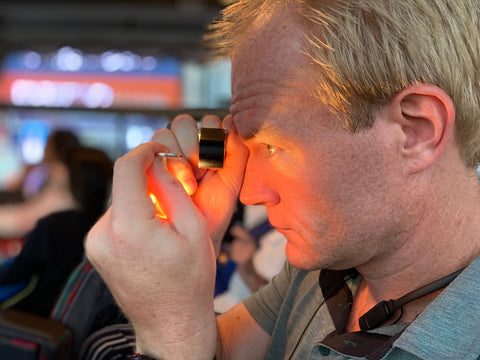
Here is Robert in Mogok inspecting a piece of jewellery for his clientele - Photo Credit: Vorachit En Runglertmaneepong
AsiaLounges: We were under the impression that you were mostly addressing the North American market, what makes it more specific or appealing than other market in your eyes? Are you also addressing other markets?
Robert Gessner: I am currently based in centre of the United States in Dallas, Texas, which gives great access to the whole North American market. As a foreigner to the States, my perspective of this country has always been, and still is, the land of opportunity. This does not mean things are easy at all. Hard work, hustling and showing up is still true today, as it's always been.
Based in the States does not mean that I ignore other markets. We are part of an online and engaged community and the world is so much smaller now that we are all connected. Broadcasting to the world is a click away, and I continue to generate a following through content, word of mouth and referrals. Very few people have my background and gemstone geology and gemmology understanding, and the engaged consumer of today wants the personal interaction, personal experience and personal jewellery, even if it starts with a click.
Underground at TanzaniteOne with Robert - Photo Credit: Gessner Gems
AsiaLounges: Back to the mines if you don’t mind (pun vaguely intended)… Can you tell us more about the mining industry as a whole, the mining processes for example. How does a mine start? It’s life cycle etc… I believe that the mines are still a very unknown part of the trade and a great many retinal images, right or wrong, seem to persist in everyone’s mind (mine included) and it could be interesting to showcase what really happens in one.
Robert Gessner: That is a very broad question, but I will start by saying that each country has its own mining laws, rules and regulations, incentives for foreign investment and growth, and policies. And so those structures are already in place. I will refer specifically to Tanzania and Zambia, as this is where I have the most experience.
In both of these countries, irrespective of whether private or public, individuals or companies, you either start with an exploration license or mining license. Both licenses have their own rules and regulations relating to how to apply, manage and maintain, and includes quarterly reports and respective fees to keep the licenses valid.
More interesting to the readers will be the mining licenses: once a private or public organisation is looking into a new or existing mining license, exploration would have delineated the potential resource (note: I do not say reserve – because reserve means the gems are guaranteed, which is not the case in the coloured gemstone mining industry). The mining department works with the geology department to calculate the desired scale of operations and decide on the best mining method to access and extract the gemstone ore (resource). The size of the resource, coupled to the chosen mining method generates a life-of-mine. Obviously, I am summarising a very complex process.
The next step, and arguably, the most important one, is the set-up of the mine closure plan. In the respective country’s Mines Act, no mine can start before the mine closure plan has been planned and budgeted for. This simply means that the environmental impact of the entire mine has to be rectified to as near perfect as possible, but planned and budgeted for at the start of operations. (Note: this does not necessarily mean that an open pit is refilled – it would mean that pits are filled with water and become dams, stocked with fish, monitored, etc. Mine dumps are covered with fertile top soil, trees planted and vegetated, etc.)

From the depths to the top of the mine, here in Kagem Emerald Mine in Zambia - Photo Credit: Gessner Gems
AsiaLounges: As you have seen with the latest ICA Congress in Bangkok, the talk of the moment is Ethical mining and Ethical everything really… what is your take on it? Would you consider these never ending ethical talks to be yet another marketing twist, a real issue that needs be addressed or a bit of both?
Robert Gessner: Yes, all the industry’s buzzwords at the moment. I do not like the word ‘ethical’ and it is the wrong word to use for mining – mining can be responsible. I feel that the word ‘ethical’ represents the goal to strive for, the light on the hill, and should not be all over the place and randomly used. So it comes down to the definition of the words and where in the industry they are used. I also feel ‘ethical’ is the new ‘pigeon-blood’ of trade terms being used incorrectly to find an edge to market and sell to the consumer. The other buzzwords are ‘responsible’, ‘sustainable’, ‘traceable’, ‘transparent’, etc. They all need to be defined to be properly understood for the respective segment of the industry.
I have just returned from a trip to Mogok, Myanmar, following the ICA Congress 2019, and after having visited the ruby, spinel and sapphire mines in Mogok, it is clear that none of these gems can be called or considered ‘ethical’, ‘responsible’ or ‘sustainable’ since the time the government stopped managing and renewing the mining licenses (so over the last 12 to 18 months). And so right now, there are no miners operating these mines. There is no safety measures in place. There is no structured blasting between the artisanal miners shafts right next to each other. But these amazing gems that drive our gem community wild are ‘traceable’. We know exactly where they are from. And that is positive.
Another positive, and this maybe even more important: the Burmese people have been mining this way for thousands of years. They have continued to provide the world the most beautiful gems in order to provide an income, a home and a living for their families, their children, their community. And they are happy. This is what they know and how it has always been done.
I feel the only way forward for our industry is the regular auditing and collecting of specific information per deposit, per region, per country, and as things politically change, etc. All of this information needs to be assembled, organised and presented (annually?, quarterly? – whatever is possible) to any and all consuming markets around the world. Let the consumer decide what and who they want to support. I see this as the only way forward, and the understanding and definitions of ‘responsible’, ‘traceable’, ‘sustainable’, will naturally generate support and a following.
Circumstance, history and government have resulted in what we see in mining regions all over the world today, and each location, country and deposit is different. No blanket definition or set of rules can be set up and forced across the industry. Provide all the information, and let the consumer decide.
Robert's Last trip to Burma (Myanmar) - Video Credit: Gessner Gems
AsiaLounges: Left to your own device and with zero market pressure, what wold be the gem you’d like to market and play with the most?
Robert Gessner: That gem would definitely be the family of garnets – both gemstones and mineral specimens. It may be the African in me, but working Southern and East Africa for my career, having seen so many deposits, and the saturation and varieties of colours still making it to the market today, is mind blowing. The fact that they are still unappreciated and maybe not quite understood is perfect for me. I love a challenge and an opportunity to share knowledge, educate and sell to my audience and followers and clients.
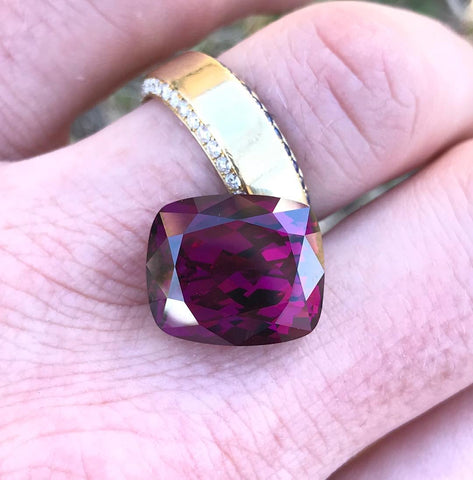
Here is a lovely Purple Garnet from the Gessner Gems Collection - Photo Credit: Gessner Gems
AsiaLounges: What is the next step for Gessner Gems aka @thekingofgemstones on Instagram? Where do you plan on carrying your company?
Robert Gessner: Awareness of my brand: Gessner Gems and @thekingofgemstones, narration of the content, continued education to my audience and the continued supply personally sourced gems and customised jewellery to my existing and growing clientele.
AsiaLounges: We are slowly reaching the end of this interview and we’d like to ask you for three pieces of advice and /or books that you’d recommend to Loungers that’d want to follow in your footsteps.
Robert Gessner: Hard work and perseverance are two qualities that a committed young geologist will need in search of and in a role/job with a coloured gemstone mine. Understandably, opportunities are limited, but they are available. Specialise – and become the best at something.
I cannot overstate the importance of travel, and getting exposed to new cultures, languages and points of view. Be open to new experiences and opportunities. Meet people and grow your personal and professional community.
In this profession, always question what you see and, and then as your career and confidence grows, learn to back yourself.
Oh…and travel, travel, travel…
Thank you for this opportunity, Asia Lounges.
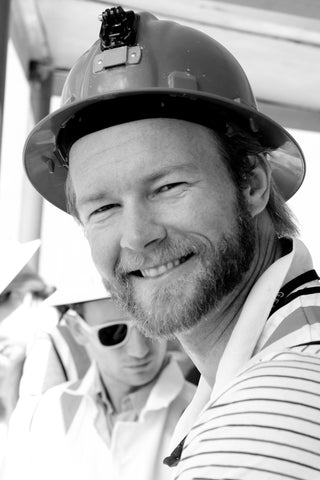
Young Robert smiling from the pit ;) - Photo Credit: Gessner Gems
AsiaLounges: Thank you very much, Robert, for being with us today, I am convinced that our readers, the Loungers, have enjoyed this interview as much as we did enjoy writing these lines.
As for us, we will meet you again soon in the Lounges with more exciting content! If you have enjoyed this content please let us know by liking, commenting and sharing our work with your family and friends and on your favourite social media platform. Don't forget that you can also support A Gem Dealer's Journal through our Patreon's Page. It will help us a lot continue with our work!
Should you have any questions, or topic that you’d like us to research or look into for a future interview, feel free to let us know by contacting us at simon@asialounges.com, it is always a pleasure to dig further into the world of gems and gemmology!
For all the rest, feel free to take a look at our gem and jewellery collection as well as to contact us should you be interested in getting one of our famed bespoke pieces of AsiaLounges Jewellery.
See you again in the Lounges,
